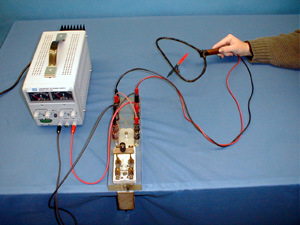Demos: 6B-01 Oersted's Experiment

The presence of a magnetic field around a current-carrying conductor is demonstrated. A heavy copper wire bent in the form of the letter “D” is connected to a 12V power supply. The straight part of the conductor is held close to a pivoted compass needle. When the current is turned on the compass needle is deflected, indicating the presence of a magnetic field.
Directions: First let the compass needle settle down to its equilibrium position (which may or may not be toward the North because of possible interferences in the room). Then hold the conductor so that the straight part is over the compass needle and parallel with it. Activate the switch so that current flows in the wire. Do not hold the switch down for more than a few seconds at a time because of the large current (~10A) in the wire. By reversing the direction of the conductor (anti-parallel to the previous arrangement), you can show that the field is in the opposite direction.
Suggestions for Presentation: After the compass needle is sitting steady, bring the wire loop to its specified position, but do NOT activate the circuit. Show that a magnet does not interact with another non-ferromagnetic material (such as copper). Now press the switch and show that there is a static magnetic field and that it is perpendicular to the conductor. This suggests that the field surrounds the wire in concentric circles.
Applications: Magnetic fields set up by electric currents such as in electric motors.
Last Updated: Nov 30, 2023 11:25 AM